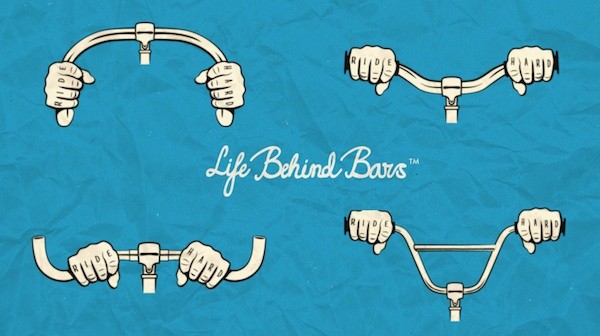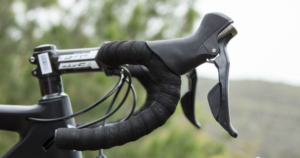You see them all the time. Cyclists who appear uncomfortable on their bike, hunched over, or sitting straight up like they have a back injury. You might even find yourself doing it, placing your hands on the hoods, down in the drops, or a combination of both, trying to get comfortable. Handlebars influence handling, stability, comfort and reliability of your bike. Lots of cyclists simply adjust their riding style to the handlebars that came on the bike, but that’s not always the best option.

Drop Bars
The majority of road bikes are equipped with drop bars. The anatomy of the drop bar is designed to give you options for hand positions. You might have heard other cyclists describe parts or features on handlebars: The horizontal part is called the top, or flat. The two portions on each side that turn 90-degrees toward your body and begin to curve down are the ramps. As the ramps curve down they turn into the hooks, the most radical curved part. Finally, the horizontal end of the bar, where you place your hands, are the drops. The two pistol-like handles where riders commonly rest their hands are commonly referred to as the brake hoods, or sometimes, the grips.
Handlebar Fit
Selecting the right handlebar requires some trial and error, but it’s easier than you might think. Assuming your frame is the right size, your bar should allow you to comfortably reach the brake hoods, with only a slight bend at the elbow. When your hands are on the hoods, or down in the drops, your wrists should be at a comfortable angle, if it feels like it’s tweaking your wrist, the fit is not good. You should be able to easily reach the brake levers from the hoods or drops.
Bar Height
The key to proper bar height is the range of motion of your neck. While riding in the drop position, you should be able to look comfortably ahead, using no more than about 80-90 percent of your range of motion in your neck. In other words, if it hurts, or no matter what you do, you can’t get used to it, the bar is too low.
Listen to Your Body
Excessive pressure in your crotch, back pain or tension after a ride, hand numbness or soreness, or even pain in the front of the hip, can indicate that your handlebars may be too low. Handlebars that are too high, won’t typically make you sore, but instead, makes you work harder, and your bike less efficient.
The Awesome Stem
Most road bikes run a threadless stem, which is the biggest asset to handlebar height adjustment. There’s a certain amount of adjustment by removing or adding spacers to the stem. But the biggest advantage is that most stems are reversible, and if you’re lucky, you’ve got a stem that angles up or down. If it’s flat or horizontal you’re out of luck. By reversing the stem and angling it downward, it places the handlebar in the aggressive riding position. Reverse the stem to pitch it upward for a more upright, passive riding posture.
Use Your Multi-Tool
This procedure is simple, it can even be done on the highway. Use the multi-tool that you should have in your underseat pack. Loosen three bolts on the stem, and four bolts on the front of the handlebars. Let the handlebars hang loosely by their cables while you flip the stem upside down, and then reinstall it. It only takes a few minutes. If you’re curious, just try it, it’s easy, if you don’t like it, change it back.
More on Stems
If you can’t get what you need out of the stem reversal, there’s hundreds of different stem lengths and pitches out there, specifically for making your handlebars and overall bike fit more comfortable. Visit your local bike shop and find one you like.
If All Else Fails
If all else fails, and you still get sore, or you feel like you’re riding in the wind all the time because you’re sitting up to high, it might be time to get a different handlebar. Switching out handlebars is not a big deal, but it’s more complicated than the stem reversal, because the brake hoods have to come off, and then there’s the tape, which is a procedure in itself.
Bar Width
Your hands should be straight out from your shoulders when riding on the hoods, or just slightly wider. If your hands are narrower than your shoulders, your bike can feel unstable, and closely-spaced hands makes it harder for you to breath properly.
Shape Implications
Two of the most common shapes are standard drop bars, and ergonomic bars. Standard drop bars have the traditional hook curve. Ergo-bars have a flat spot on the hook shape. It’s designed for your hand, so that it doesn’t bend when you’re in the drops. The ergo bar has revolutionized comfort for some cyclists, while others hate it. Other options for reach, deeper drops, or almost any other configuration you can dream up are all out there, waiting for you. It’s a personal choice. Decide for yourself which one you like best.
Bar Material
The majority of handlebars are still made with aluminum. It’s lightweight and strong. Aluminum does transfer vibration though, and some cyclists claim it has a harsh feel. Carbon-fiber bars are expensive, but they reduce vibration like nothing else. Claims that carbon shatters shouldn’t be taken too seriously. Carbon handlebars are strong, reliable, comfortable and lighter than aluminum. One big advantage — it’s easy to form carbon bars into a wing-shape, allowing for a bigger, more comfortable hand position when riding. If you need to take a break and just cruise for a while, resting your palms on the wing brings back blood flow. Plus that, carbon handlebars just look cool.